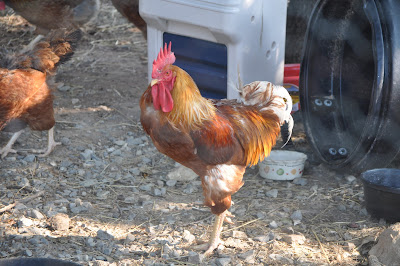There was something in the air this morning. With Richard in the hospital for knee
surgery, I took on the added task of feeding the cat, dogs and chickens. As I approached the chicken coop, the rooster
took on an aggressive posture on the other side of the gate. I had to wait for him to back away before I
could enter so he wouldn’t get out.
 |
| This is him |
After I entered his area, he attacked and I had to fend him
off with the large stick I carry with me whenever I go into his pen. I pushed him back several times with the
stick and then I lost my patience and kicked him about three feet in the
air. Nothing deterred him and he came
back at me and I had to fend him off with the stick for the entire time I was
feeding them and collecting the eggs. He
distracted me so much that when I finally departed, I left the eggs sitting on
the ledge and had to return for them later.
I have never understood why a small animal with no arms and
very short legs would attack something as large as a human. I could have squashed him at any moment and
we would be eating chicken and dumplings tonight! To get even, I tormented him with the water
hose for 15 minutes or so and reduced him from “King of the roost” to a minor
Duke. When I left, he was crowing about
every 30 seconds trying to reestablish his dominance and regain his
throne. I can’t wait for tomorrow.
Even the calves, who are usually very docile and timid,
stood their ground when the two dogs tried to chase them off. Normally they run as soon as they see the
dogs coming, but this morning one of them stood face to face with the dog for a
few seconds. I’ve never seen them do
that before. One of them actually came
back and confronted the dog after the dog had given up the chase! Eventually the dogs won out, as they always do, but that show of aggression by the calves was unusual. I was actually proud of them!














